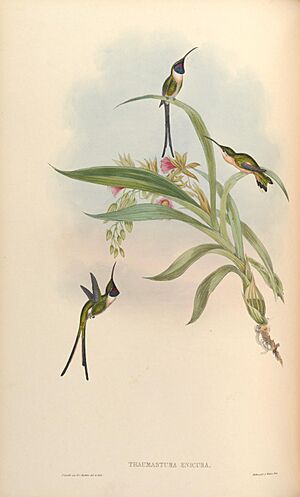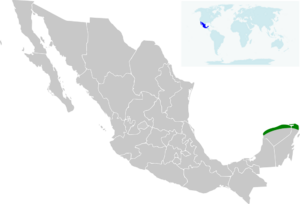Slender sheartail facts for kids
Quick facts for kids Slender sheartail |
|
|---|---|
 |
|
| Conservation status | |
| Scientific classification | |
| Genus: |
Doricha
|
| Species: |
enicura
|
 |
|
| Synonyms | |
|
Trochilus enicurus (protonym) |
|
The slender sheartail (Doricha enicura) is a small, colorful hummingbird. It is known for its long, forked tail, especially in males. This bird lives in parts of Central America. You can find it in countries like El Salvador, Guatemala, Honduras, and Mexico.
Contents
About the Slender Sheartail
How Scientists Classify It
The slender sheartail belongs to a group of hummingbirds called Doricha. Its closest relative is the Mexican sheartail. Scientists consider the slender sheartail to be a unique species. This means it does not have different types or subspecies.
What It Looks Like
Male slender sheartails are about 11 to 12.5 centimeters (4.3 to 4.9 inches) long. They weigh around 2.3 grams (0.08 ounces). Females are a bit smaller, about 8 to 9 centimeters (3.1 to 3.5 inches) long. They weigh about 2.6 grams (0.09 ounces).
Both male and female birds have a long, curved black beak. They also have a small white spot behind each eye.
- Males: Their head, back, and sides are green. They have a bright pinkish-purple throat, called a gorget. Their chest and the middle of their belly are white. The male's tail is very long and deeply forked. The two middle feathers are green, and the rest are black.
- Females: Their upper parts are green. Their underparts are a warm cinnamon-buff color. They have a dark stripe that goes through their eye. The female's tail is much shorter and less forked than the male's. Its middle feathers are green. The other tail feathers are cinnamon with a wide black band near the tip and white tips.
Where It Lives
Habitat and Location
The slender sheartail lives in mountains and valleys. You can find it from southern Mexico (in a state called Chiapas) all the way through Guatemala and northeastern El Salvador into Honduras.
It likes places that are partly open. These include forest clearings, woodlands, and areas with new forest growth. It also lives in scrublands. These birds are found at high elevations, usually between 1,000 and 3,000 meters (3,300 and 9,800 feet) above sea level.
How It Behaves
Movement and Migration
The slender sheartail usually stays in one area. It does not travel long distances like some other birds. However, the number of birds in certain places can change throughout the year.
What It Eats
This hummingbird eats two main things:
- Nectar: It sips nectar from flowers. Nectar is a sweet liquid that gives the bird energy.
- Small insects: It also catches tiny insects and other small creatures. These provide important protein.
It looks for food from the ground level up to the middle parts of trees and bushes. When a male bird feeds on nectar, it often holds its long tail almost straight up. Females, however, wag their tails and open and close them while feeding.
Reproduction and Life Cycle
Scientists do not know much about how the slender sheartail reproduces. They have seen it breeding in October in Chiapas, Mexico. But more research is needed to understand its full breeding habits.
Sounds It Makes
The sounds of the slender sheartail are not well known. It has not been recorded very often. When it is sitting or eating, it makes "fairly hard, rapid chips."
Conservation Status
Is It Endangered?
The IUCN (International Union for Conservation of Nature) has looked at the slender sheartail. They have decided it is a species of "Least Concern." This means it is not currently in danger of disappearing.
The bird lives in a fairly large area. Its population is estimated to be between 20,000 and 50,000 adult birds. However, scientists believe the number of slender sheartails is slowly going down. It can be rare in some places but common in others. The biggest threat to this bird is people clearing its habitat to create farmland.



